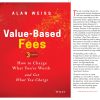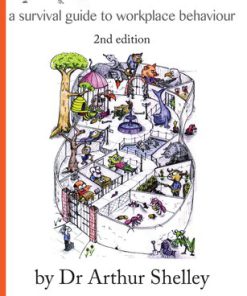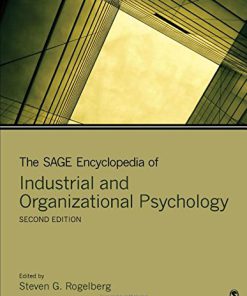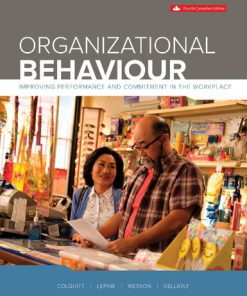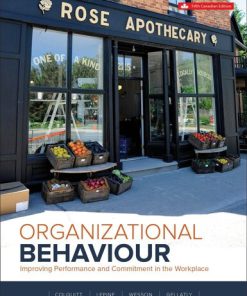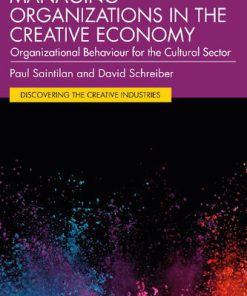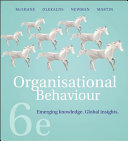Canadian Organizational Behaviour 11th Edition by Steven Mcshane, Kevin Tasa, Sandra Steen 1260326853 9781260326857
$50.00 Original price was: $50.00.$25.00Current price is: $25.00.
Canadian Organizational Behaviour 11th Edition by Steven Mcshane, Kevin Tasa, Sandra Steen – Ebook PDF Instant Download/Delivery: 1260326853, 9781260326857
Full download Canadian Organizational Behaviour 11th Edition after payment

Product details:
ISBN 10: 1260326853
ISBN 13: 9781260326857
Author: Steven Mcshane, Kevin Tasa, Sandra Steen
Canadian Organizational Behaviour reflects the dynamic world of organizational behaviour and emerging workplace realities – social media and virtual teams; values and self-leadership; emotional intelligence and effective teamwork skills. Canadian Organizational Behaviour, Eleventh Edition, is written in the context of these emerging workplace realities. This edition explains how work-life integration is becoming an essential employee practice in the workplace.
Canadian Organizational Behaviour 11th Table of contents:
Chapter 1: Introduction to the Field of Organizational Behaviour
Introduction
Introduction to the Field of Organizational Behaviour
Welcome to the Field of Organizational Behaviour!
What is Organizational Behaviour?
HISTORICAL FOUNDATIONS OF ORGANIZATIONAL BEHAVIOUR
Why Organizational Behaviour Is Important
Why OB is Important for You
Why OB is Important for Organizations
Connecting the Dots: An Integrative Model of Organizational Behaviour
Anchors of Organizational Behaviour Knowledge
THE SYSTEMATIC RESEARCH ANCHOR
THE PRACTICAL ORIENTATION ANCHOR
THE MULTIDISCIPLINARY ANCHOR
THE CONTINGENCY ANCHOR
THE MULTIPLE LEVELS OF ANALYSIS ANCHOR
The Emerging Workplace Landscape
Diversity and the Inclusive Workplace
Work–Life Integration
Remote Work
Employment Relationships
MARS Model of Individual Behaviour and Performance
EMPLOYEE MOTIVATION
ABILITY
ROLE PERCEPTIONS
SITUATIONAL FACTORS
Types of Individual Behaviour
TASK PERFORMANCE
ORGANIZATIONAL CITIZENSHIP BEHAVIOURS
COUNTERPRODUCTIVE WORK BEHAVIOURS
JOINING AND STAYING WITH THE ORGANIZATION
MAINTAINING WORK ATTENDANCE
The Journey Begins
Chapter Summary
Key Terms
Critical Thinking Questions
Case Study: Promoting Safe Behaviour at Mother Parkers
Class Exercise: World Café on the Emerging Workplace
World Café Discussion Themes
Class Exercise: It All Makes Sense?
Self-Assessment for Chapter 1
Chapter 2: Individual Differences: Personality and Values
Introduction
Individual Differences: Personality and Values
Personality and the Five-Factor Model in Organizations
WHAT CAUSES PERSONALITY: NATURE VERSUS NURTURE
FIVE-FACTOR MODEL OF PERSONALITY
Caveats When Applying the Five-Factor Model
Other Personality Concepts: The Dark Triad and MBTI Types
The Dark Triad
JUNGIAN PERSONALITY THEORY AND THE MYERS-BRIGGS TYPE INDICATOR
Values in the Workplace
TYPES OF VALUES
VALUES AND INDIVIDUAL BEHAVIOUR
VALUES CONGRUENCE
Ethical Values and Behaviour
FOUR ETHICAL PRINCIPLES
MORAL INTENSITY, MORAL SENSITIVITY, AND SITUATIONAL INFLUENCES
SUPPORTING ETHICAL BEHAVIOUR
Values Across Cultures
INDIVIDUALISM AND COLLECTIVISM
POWER DISTANCE
UNCERTAINTY AVOIDANCE
ACHIEVEMENT-NURTURING ORIENTATION
CAVEATS ABOUT CROSS-CULTURAL KNOWLEDGE
CULTURAL DIVERSITY WITHIN CANADA
Chapter Summary
Key Terms
Critical Thinking Questions
Case Study: SNC-Lavalin Group Inc.
Team Exercise: Ethics Dilemma Vignettes
Class Exercise: Personal Values Exercise
Self-Assessments for Chapter 2
Chapter 3: Perceiving Ourselves and Others in Organizations
Introduction
Self-Concept: How We Perceive Ourselves
SELF-CONCEPT COMPLEXITY, CONSISTENCY, AND CLARITY
SELF-ENHANCEMENT
SELF-VERIFICATION
SELF-EVALUATION
THE SOCIAL SELF
SELF-CONCEPT AND ORGANIZATIONAL BEHAVIOUR
Perceiving the World Around Us
PERCEPTUAL ORGANIZATION AND INTERPRETATION
Specific Perceptual Processes and Problems
STEREOTYPING IN ORGANIZATIONS
ATTRIBUTION THEORY
SELF-FULFILLING PROPHECY
OTHER PERCEPTUAL EFFECTS
Improving Perceptions
AWARENESS OF PERCEPTUAL BIASES
IMPROVING SELF-AWARENESS
MEANINGFUL INTERACTION
Global Mindset: Developing Perceptions across Borders
DEVELOPING A GLOBAL MINDSET
Chapter Summary
Key Terms
Critical Thinking Questions
Case Study: Hy Dairies Ltd
Team Exercise: Personal and Organizational Strategies for Developing a Global Mindset
Self-Assessments for Chapter 3
Chapter 4: Workplace Emotions, Attitudes, and Stress
Introduction
Emotions in the Workplace
TYPES OF EMOTIONS
EMOTIONS, ATTITUDES, AND BEHAVIOUR
HOW EMOTIONS INFLUENCE ATTITUDES AND BEHAVIOUR
GENERATING POSITIVE EMOTIONS AT WORK
COGNITIVE DISSONANCE
EMOTIONS AND PERSONALITY
Managing Emotions at Work
EMOTIONAL DISPLAY NORMS ACROSS CULTURES
Strategies for Displaying Expected Emotions
Emotional Intelligence
EMOTIONAL INTELLIGENCE OUTCOMES AND DEVELOPMENT
Job Satisfaction
JOB SATISFACTION AND WORK BEHAVIOUR
JOB SATISFACTION AND PERFORMANCE
JOB SATISFACTION AND CUSTOMER SATISFACTION
JOB SATISFACTION AND BUSINESS ETHICS
Organizational Commitment
CONSEQUENCES OF AFFECTIVE AND CONTINUANCE COMMITMENT
BUILDING AFFECTIVE COMMITMENT
Work-Related Stress and its Management
GENERAL ADAPTATION SYNDROME
CONSEQUENCES OF DISTRESS
STRESSORS: THE CAUSES OF STRESS
INDIVIDUAL DIFFERENCES IN STRESS
MANAGING WORK-RELATED STRESS
Chapter Summary
Key Terms
Critical Thinking Questions
Case Study: Diana’s Disappointment: The Promotion Stumbling Block
Case Study: Rough Seas on the Link650
Team Exercise: Ranking Jobs on Their Emotional Labour
Self-Assessments for Chapter 4
Chapter 5: Foundations of Employee Motivation
Introduction
Employee Motivation, Drives, and Needs
Employee Drives and Needs
INDIVIDUAL DIFFERENCES IN NEEDS
Drive-Based Motivation Theories
FOUR-DRIVE THEORY
MASLOW’S NEEDS HIERARCHY THEORY
INTRINSIC AND EXTRINSIC MOTIVATION
LEARNED NEEDS THEORY
Expectancy Theory of Motivation
EXPECTANCY THEORY IN PRACTICE
Organizational Behaviour Modification and Social Cognitive Theory
ORGANIZATIONAL BEHAVIOUR MODIFICATION
SOCIAL COGNITIVE THEORY
Goal Setting and Feedback
CHARACTERISTICS OF EFFECTIVE FEEDBACK
SOURCES OF FEEDBACK
EVALUATING GOAL SETTING AND FEEDBACK
Organizational Justice
Distributive Justice and Equity Theory
PROCEDURAL and Interactional JUSTICE
Chapter Summary
Key Terms
Critical Thinking Questions
Case Study: Predicting Harry’s Work Effort
Case Study: Barrie Super Subs
Class Exercise: Needs Priority Exercise
Self-Assessments for Chapter 5
Chapter 6: Applied Performance Practices
Introduction
The Meaning of Money in the Workplace
Financial Reward Practices
MEMBERSHIP- AND SENIORITY-BASED REWARDS
JOB STATUS–BASED REWARDS
COMPETENCY-BASED REWARDS
PERFORMANCE-BASED REWARDS
Improving Reward Effectiveness
Link Rewards to Performance
Ensure That Rewards are Relevant
Use Team Rewards for Interdependent Jobs
Ensure that Rewards Are Valued
Watch Out for Unintended Consequences
Job Design Practices
JOB DESIGN AND WORK EFFICIENCY
SCIENTIFIC MANAGEMENT
PROBLEMS WITH JOB SPECIALIZATION
Job Design and Work Motivation
Job Characteristics MODEL
SOCIAL AND INFORMATION PROCESSING JOB CHARACTERISTICS
JOB DESIGN PRACTICES THAT MOTIVATE
Psychological Empowerment Practices
SUPPORTING PSYCHOLOGICAL EMPOWERMENT
Self-Leadership Practices
Personal Goal Setting
CONSTRUCTIVE THOUGHT PATTERNS
Designing Natural Rewards
Self-Monitoring
Self-Reinforcement
EFFECTIVENESS OF SELF-LEADERSHIP
PERSONAL AND SITUATIONAL PREDICTORS OF SELF-LEADERSHIP
Chapter Summary
Key Terms
Critical Thinking Questions
Case Study: Yakkatech Ltd
Team Exercise: Is Student Work Enriched?
Self-Assessments for Chapter 6
Chapter 7: Decision Making and Creativity
Introduction
Decision Making and Creativity
Rational Choice Decision Making
RATIONAL CHOICE DECISION PROCESS
PROBLEMS WITH RATIONAL CHOICE DECISION MAKING
Identifying Problems and Opportunities
PROBLEMS WITH PROBLEM IDENTIFICATION
IDENTIFYING PROBLEMS AND OPPORTUNITIES MORE EFFECTIVELY
Searching for, Evaluating, and Choosing Alternatives
PROBLEMS WITH GOALS
PROBLEMS WITH INFORMATION PROCESSING
PROBLEMS WITH MAXIMIZATION
EVALUATING OPPORTUNITIES
Emotions and Intuition in Decision Making
EMOTIONS AND MAKING CHOICES
INTUITION AND MAKING CHOICES
MAKING CHOICES MORE EFFECTIVELY
Implementing and Evaluating Decisions
Implementing Decisions
Evaluating Decisions
ESCALATION OF COMMITMENT
EVALUATING DECISION OUTCOMES MORE EFFECTIVELY
Creativity
THE CREATIVE PROCESS
CHARACTERISTICS OF CREATIVE PEOPLE
ORGANIZATIONAL CONDITIONS SUPPORTING CREATIVITY
ACTIVITIES THAT ENCOURAGE CREATIVITY
Employee Involvement in Decision Making
BENEFITS OF EMPLOYEE INVOLVEMENT
CONTINGENCIES OF EMPLOYEE INVOLVEMENT
Chapter Summary
Key Terms
Critical Thinking Questions
Case Study: Dogged by the Wrong Problem
Class Exercise: Employee Involvement Incidents
Class Exercise: Creativity Brainbusters
Self-Assessments for Chapter 7
Chapter 8: Team Dynamics
Introduction
Teams and Informal Groups
INFORMAL GROUPS
Benefits and Limitations of Teams
THE CHALLENGES OF TEAMS
A Model of Team Effectiveness
ORGANIZATIONAL AND TEAM ENVIRONMENT
Team Design Elements
TASK CHARACTERISTICS
TEAM SIZE
TEAM COMPOSITION
Team Processes
TEAM DEVELOPMENT
TEAM NORMS
Team Roles
TEAM COHESION
TEAM TRUST
TEAM MENTAL MODELS
Improving Team Processes through Team Building
Self-Directed Teams
SUCCESS FACTORS FOR SELF-DIRECTED TEAMS
Remote (Virtual) Teams
SUCCESS FACTORS FOR REMOTE TEAMS
Team Decision Making
CONSTRAINTS ON TEAM DECISION MAKING
IMPROVING DECISION MAKING AND CREATIVITY IN TEAMS
Chapter Summary
Key Terms
Critical Thinking Questions
Case Study: Arbrecorp Ltée
Team Exercise: Team Tower Power
Team Exercise: Survival on the Moon
Self-Assessments for Chapter 8
Chapter 9: Communicating in Teams and Organizations
Introduction
The Importance of Communication
A Model of Communication
INFLUENCES ON EFFECTIVE ENCODING AND DECODING
Communication Channels
DIGITAL WRITTEN COMMUNICATION
Social Media Communication in the Workplace
NONVERBAL COMMUNICATION
Choosing the Best Communication Channel
Synchronicity
Social Presence
SOCIAL ACCEPTANCE
MEDIA RICHNESS
COMMUNICATION CHANNELS AND PERSUASION
Communication Barriers (NOISE)
Perceptions
Language
Jargon
Filtering
INFORMATION OVERLOAD
Cross-Cultural and Gender Communication
NONVERBAL DIFFERENCES ACROSS CULTURES
GENDER DIFFERENCES IN COMMUNICATION
Improving Interpersonal Communication
GETTING YOUR MESSAGE ACROSS
ACTIVE LISTENING
Improving Communicationthroughout the Hierarchy
WORKSPACE DESIGN
DIGITALLY BASED ORGANIZATIONAL COMMUNICATION
DIRECT COMMUNICATION WITH TOP MANAGEMENT
Communicating through the Grapevine
GRAPEVINE CHARACTERISTICS
GRAPEVINE BENEFITS AND LIMITATIONS
Chapter Summary
Key Terms
Critical Thinking Questions
Case Study: Difficult Connections
Team Exercise: Cross-Cultural Communication Game
Team Exercise: Practising Active Listening
Self-Assessments for Chapter 9
Chapter 10: Power and Influence in the Workplace
Introduction
The Meaning of Power
Sources of Power in Organizations
LEGITIMATE POWER
REWARD POWER
COERCIVE POWER
EXPERT POWER
REFERENT POWER
Deference to Power
Contingencies of Power
NONSUBSTITUTABILITY
CENTRALITY
VISIBILITY
DISCRETION
The Power of Social Networks
SOCIAL CAPITAL AND SOURCES OF POWER
GAINING POWER THROUGH SOCIAL NETWORKS
Consequences of Power
Influencing Others
TYPES OF INFLUENCE TACTICS
CONSEQUENCES AND CONTINGENCIES OF INFLUENCE TACTICS
Organizational Politics
Individual Differences in Organizational Politics
MINIMIZING ORGANIZATIONAL POLITICS
Chapter Summary
Key Terms
Critical Thinking Questions
Case Study: Resonus Corporation
Case Study: JP Morgan’s Whale
Team Exercise: Deciphering the (Social) Network
Team Exercise: Managing Your Boss
Self-Assessments for Chapter 10
Chapter 11: Conflict and Negotiation in the Workplace
Introduction
The Meaning and Consequences of Conflict
IS CONFLICT GOOD OR BAD?
The Emerging View: Task and Relationship Conflict
Task Conflict
Relationship Conflict
Minimizing Relationship Conflict During Task Conflict
Conflict Process Model
Structural Sources of Conflict in Organizations
INCOMPATIBLE GOALS
DIFFERENTIATION
INTERDEPENDENCE
SCARCE RESOURCES
AMBIGUOUS RULES
COMMUNICATION PROBLEMS
Interpersonal Conflict-Handling Styles
CHOOSING THE BEST CONFLICT-HANDLING STYLE
CULTURAL AND GENDER DIFFERENCES IN CONFLICT-HANDLING STYLES
Structural Approaches to Conflict Management
EMPHASIZE SUPERORDINATE GOALS
REDUCE DIFFERENTIATION
IMPROVE COMMUNICATION AND MUTUAL UNDERSTANDING
REDUCE INTERDEPENDENCE
INCREASE RESOURCES
CLARIFY RULES AND PROCEDURES
Third-Party Conflict Resolution
CHOOSING THE BEST THIRD-PARTY INTERVENTION STRATEGY
Resolving Conflict through Negotiation
DISTRIBUTIVE VERSUS INTEGRATIVE APPROACHES TO NEGOTIATION
PREPARING TO NEGOTIATE
THE NEGOTIATION PROCESS
The Negotiation Setting
Gender and Negotiation
Chapter Summary
Key Terms
Critical Thinking Questions
Case Study: Discord Investments
Class Exercise: Conflict Handling Incidents
Team Exercise: Kumquat Conflict Role Play
Self-Assessments for Chapter 11
Chapter 12: Leadership in Organizational Settings
Introduction
What is Leadership?
SHARED LEADERSHIP
Transformational Leadership Perspective
DEVELOP AND COMMUNICATE A STRATEGIC VISION
MODEL THE VISION
ENCOURAGE EXPERIMENTATION
BUILD COMMITMENT TOWARD THE VISION
TRANSFORMATIONAL LEADERSHIP AND CHARISMA
EVALUATING THE TRANSFORMATIONAL LEADERSHIP PERSPECTIVE
Managerial Leadership Perspective
Interdependence OFManagerial andTransformational LEadership
TASK-ORIENTED AND PEOPLE-ORIENTED LEADERSHIP
SERVANT LEADERSHIP
Path–Goal and Leadership Substitutes Theories
PATH–GOAL LEADERSHIP THEORY
LEADERSHIP SUBSTITUTES THEORY
Implicit Leadership Perspective
PROTOTYPES OF EFFECTIVE LEADERS
THE ROMANCE OF LEADERSHIP
Personal Attributes Perspective of Leadership
Eight Important Leadership Attributes
AUTHENTIC LEADERSHIP
PERSONAL ATTRIBUTES PERSPECTIVE LIMITATIONS AND PRACTICAL IMPLICATIONS
Cross-Cultural and Gender Issues in Leadership
GENDER AND LEADERSHIP
Chapter Summary
Key Terms
Critical Thinking Questions
Case Study: A Window on Life
Team Exercise: Leadership Diagnostic Analysis
Self-Assessments for Chapter 12
Chapter 13: Designing Organizational Structures
Introduction
Designing Organizational Structures
Division of Labour and Coordination
DIVISION OF LABOUR
COORDINATING WORK ACTIVITIES
Elements of Organizational Structure
SPAN OF CONTROL
CENTRALIZATION AND DECENTRALIZATION
FORMALIZATION
MECHANISTIC VERSUS ORGANIC STRUCTURES
Forms of Departmentalization
SIMPLE STRUCTURE
FUNCTIONAL STRUCTURE
DIVISIONAL STRUCTURE
TEAM-BASED STRUCTURE
MATRIX STRUCTURE
NETWORK STRUCTURE
Contingencies of Organizational Design
EXTERNAL ENVIRONMENT
ORGANIZATIONAL SIZE
TECHNOLOGY
ORGANIZATIONAL STRATEGY
Chapter Summary
Key Terms
Critical Thinking Questions
Case Study: Merritt’s Bakery
Team Exercise: The Club Ed Exercise
Self-Assessments for Chapter 13
Chapter 14: Organizational Culture
Introduction
Elements of Organizational Culture
CONTENT OF ORGANIZATIONAL CULTURE
ORGANIZATIONAL SUBCULTURES
Deciphering Organizational Culturethrough Artifacts
ORGANIZATIONAL STORIES AND LEGENDS
ORGANIZATIONAL LANGUAGE
RITUALS AND CEREMONIES
PHYSICAL STRUCTURES AND SYMBOLS
Is Organizational Culture Important?
THE MEANING AND POTENTIAL BENEFITS OF A STRONG CULTURE
CONTINGENCIES OF ORGANIZATIONAL CULTURE AND EFFECTIVENESS
ORGANIZATIONAL CULTURE AND BUSINESS ETHICS
Merging Organizational Cultures
BICULTURAL AUDIT
STRATEGIES FOR MERGING DIFFERENT ORGANIZATIONAL CULTURES
Changing and Strengthening Organizational Culture
MODEL DESIRED CULTURE THROUGH ACTIONS OF FOUNDERS AND LEADERS
ALIGN ARTIFACTS WITH THE DESIRED CULTURE
INTRODUCE CULTURALLY CONSISTENT REWARDS AND RECOGNITION
SUPPORT WORKFORCE STABILITY AND COMMUNICATION
USE ATTRACTION, SELECTION, AND SOCIALIZATION FOR CULTURAL FIT
Organizational Socialization
LEARNING AND ADJUSTMENT PROCESS
PSYCHOLOGICAL CONTRACTS
STAGES OF ORGANIZATIONAL SOCIALIZATION
IMPROVING THE SOCIALIZATION PROCESS
Chapter Summary
Key Terms
Critical Thinking Questions
Case Study: Hillton’s Transformation
Team Exercise: Organizational Culture Metaphors
Self-Assessment for Chapter 14
Chapter 15: Organizational Change
Introduction
Lewin’s Force Field Analysis Model
Understanding Resistance to Change
WHY EMPLOYEES RESIST CHANGE
Unfreezing, Changing, and Refreezing
CREATING AN URGENCY FOR CHANGE
REDUCING THE RESTRAINING FORCES
REFREEZING THE DESIRED CONDITIONS
Leadership, Coalitions, and Pilot Projects
TRANSFORMATIONAL LEADERSHIP AND CHANGE
COALITIONS, SOCIAL NETWORKS, AND CHANGE
PILOT PROJECTS AND DIFFUSION OF CHANGE
Four Approaches to Organizational Change
ACTION RESEARCH APPROACH
APPRECIATIVE INQUIRY APPROACH
LARGE GROUP INTERVENTION APPROACH
PARALLEL LEARNING STRUCTURE APPROACH
Cross-Cultural and Ethical Issues in Organizational Change
Organizational Behaviour: The Journey Continues
Chapter Summary
Key Terms
Critical Thinking Questions
Case Study: Transact Insurance Corporation
Team Exercise: Strategic Change Incidents
Self-Assessments for Chapter 15
Additional Cases
Introduction
Case 1: Arctic Mining Consultants
Case 2: Bridging the Two Worlds: The Organizational Dilemma
Case 3: Keeping Suzanne Chalmers
Case 4: Northwest Canadian Forest Products Limited (Revised)
Case 5: Simmons Laboratories
Case 6: Tamarack Industries
Case 7: The Outstanding Faculty Award
Case 8: The Regency Grand Hotel
Case 9: The Shipping Industry Accounting Team
Case 10: Verberg Kansen N.V.
Case 11: Vêtements Ltée
Appendix: Theory Building and Systematic Research Methods
Introduction
Theory Building
Positivism versus Interpretivism
Theory Testing: The Deductive Process
Using the Scientific Method
Grounded Theory: An Alternative Approach
Selected Issues in Organizational Behaviour Research
Research Design Strategies
People also search for Canadian Organizational Behaviour 11th:
canadian organizational behaviour mcshane tasa steen mcgraw hill 11th edition
canadian organizational behaviour (11th edition) isbn
canadian organizational behaviour canadian edition 11th edition
canadian organizational behaviour (11th ed)
Tags:
Steven Mcshane,Kevin Tasa,Sandra Steen,Canadian
You may also like…
Business & Economics - Management & Leadership
Science Fiction - Fantasy Fiction
The Book of Destiny The Last Oracle 9 1st Edition by Melissa Mcshane ISBN B08FXBWR58
Business & Economics - Responsibility and Business Ethics
The Organizational Zoo A Survival Guide to Workplace Behaviour 2nd Edition Arthur Shelley
History & Research
The Sage Encyclopedia of Industrial and Organizational Psychology 2nd Edition Steven G. Rogelberg
Business & Economics - Management & Leadership
Business & Economics - Management & Leadership
Uncategorized
Business & Economics - Management & Leadership
Business & Economics - Management & Leadership
Organisational Behaviour Emerging Knowledge Global Insights Steven Mcshane


